Most kids grow up learning they cannot draw on the walls. But it might be time to unlearn that training-this summer, a group of culture addicts, artists and community organizers are inviting New Yorkers to write all over the walls of an old house on Governor's Island.
The project is called Writing On It All, and it's a participatory writing project and artistic experiment that has happened on Governor's Island every summer since 2013.
"Most of the participants are people who are just walking by or are on the island for other reasons, or they just kind of happen to be there," Alexandra Chasin, artistic director of Writing On It All, tells Smithsonian, com.
The 2016 season runs through June 26 and features sessions facilitated by everyone from dancers to domestic workers. Each session has a theme, and participants are given a variety of materials and prompts and asked to cover surfaces with their thoughts and art. This year, the programs range from one that turns the house into a collaborative essay to one that explores the meaning of exile.
Governor's Island is a national historic landmark district long used for military purposes. Now known as "New York's shared space for art and play," the island, which lies between Manhattan and Brooklyn in Upper New York Bay, is closed to cars but open to summer tourists who flock for festivals, picnics, adventures, as well as these "legal graffiti (涂鸦)" sessions.
The notes and art scribbled (涂画)on the walls are an experiment in self-expression. So far, participants have ranged in age from 2 to 85. Though Chasin says the focus of the work is on the activity of writing, rather than the text that ends up getting written, some of the work that comes out of the sessions has stuck with her.
"One of the sessions that moved me the most was state violence on black women and black girls," says Chasin, explaining that in one room, people wrote down the names of those killed because of it. "People do beautiful work and leave beautiful messages."
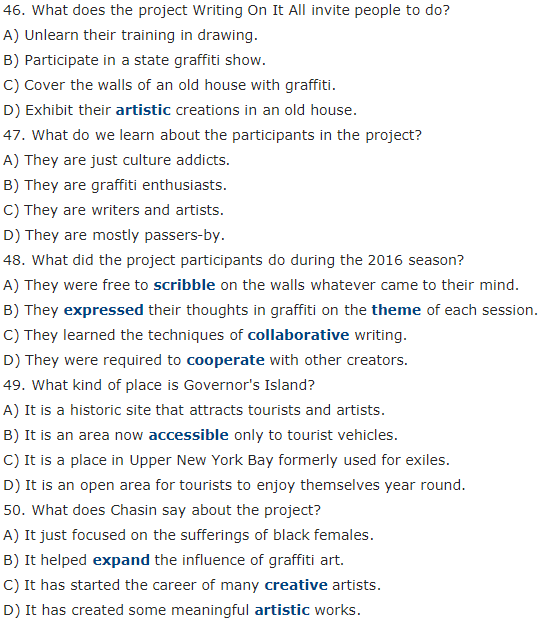
46-50:CDBAD
Textbooks represent an 11 billion dollar industry, up from $8 billion in 2014. Textbook publisher Pearson is the largest publisher -- of any kind -- in the world.
It costs about $1 million to create a new textbook. A freshman textbook will have dozens of contributors, from subject-matter experts through graphic and layout artists to expert reviewers and classroom testers. Textbook publishers connect professors, instructors and students in ways that alternatives, such as open e-textbooks and open educational resources, simply do not. This connection happens not only by means of collaborative development, review and testing, but also at conferences where faculty regularly decide on their textbooks and curricula for the coming year.
It is true that textbook publishers have recently reported losses, largely due to students renting or buying used print textbooks. But this can be chalked up to the excessively high cost of their books -- which has increased over 1,000 percent since 1977. A restructuring of the textbook industry may well be in order. But this does not mean the end of the textbook itself.
While they may not be as dynamic as an iPad, textbooks are not passive or lifeless. For example, over the centuries, they have simulated (模拟) dialogues in a number of ways. From 1800 to the present day, textbooks have done this by posing questions for students to answer inductively (归纳性地). That means students are asked to use their individual experience to come up with answers to general questions. Today's psychology texts, for example, ask: "How much of your personality do you think you inherited?" while ones in physics say: "How can you predict where the ball you tossed will land?"
Experts observe that "textbooks come in layers, something like an onion." For an active learner, engaging with a textbook can be an interactive experience. Readers proceed at their own pace. They "customize" their books by engaging with different layers and linkages. Highlighting, Post-It notes, dog-ears and other techniques allow for further customization that students value in print books over digital forms of books.
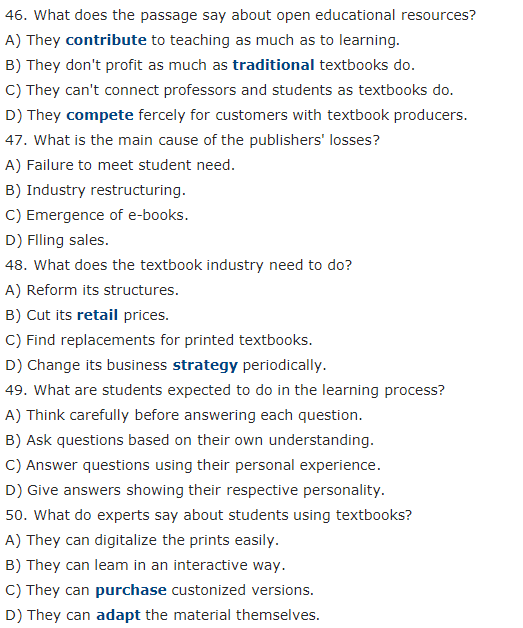
When we think of animals and plants, we have a pretty good way of dividing them into two distinct groups: one converts sunlight into energy and the other has to eat food to make its energy. Well, those dividing lines come crashing down with the discovery of a sea slug (海蛞蝓) that's truly half animal and half plant. It's pretty incredible how it has managed to hijack the genes of the algae (藻类) on which it feeds.
The slugs can manufacture chlorophyll, the green pigment (色素) in plants that captures energy from sunlight, and hold these genes within their body. The term kleptoplasty is used to describe the practice of using hijacked genes to create nutrients from sunlight. And so far, this green sea slug is the only known animal that can be truly considered solar-powered, although some animals do exhibit some plant-like behaviors. Many scientists have studied the green sea slugs to confirm that they are actually able to create energy from sunlight.
In fact, the slugs use the genetic material so well that they pass it on to their future generations. Their babies retain the ability to produce their own chlorophyll, though they can't generate energy from sunlight until they've eaten enough algae to steal the necessary genes, which they can't yet produce on their own.
"There's no way on earth that genes from an alga should work inside an animal cell," says Sidney Pierce from the University of South Florida. "And yet here, they do. They allow the animal to rely on sunshine for its nutrition. So if something happens to their food source, they have a way of not starving to death until they find more algae to eat."
The sea slugs are so good at gathering energy from the sun that they can live up to nine months without having to eat any food. They get all their nutritional needs met by the genes that they've hijacked from the algae.
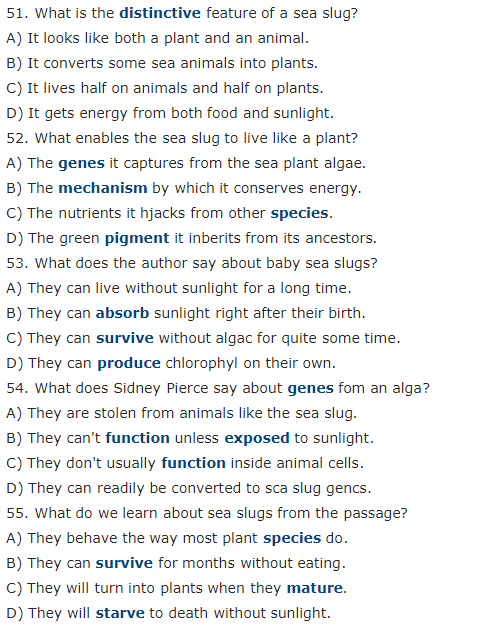
For this part, you are allowed 30 minutes to write a letter to a foreign friend who wants to teach English in China. Please recommend a city to him. You should write at least 120 words but no more than 180 words.
A) We've always been a hands-on, do it-yourself kind of nation. Ben Franklin, one of America's founding fathers, didn't just invent the lightning rod. His creations include glasses, innovative stoves and more.
B) Franklin, who was largely self-taught, may have been a genius, but he wasn't really an exception when it comes to American making and creativity.
C) The personal computing revolution and philosophy of disruptive innovation of Silicon Valley grew, in part, out of the creations of the Homebrew Computer Club, which was founded in a garage in Menlo Park, California, in the mid-1970s. Members-including guys named Jobs and Wozniak-started making and inventing things they couldn't buy.
D) So it's no surprise that the Maker Movement today is thriving in communities and some schools across America. Making is available to ordinary people who aren't tied to big companies, big defense labs or research universities. The maker philosophy echoes old ideas advocated by John Dewey, Montessori, and even ancient Greek philosophers, as we pointed out recently.
E) These maker spaces are often outside of classrooms, and are serving an important educational function. The Maker Movement is rediscovering learning by doing, which is Dewey's phrase from 100 years ago. We are rediscovering Dewey and Montessori and a lot of the practices that they pioneered that have been forgotten or at least put aside. A maker space is a place which can be in a school, but it doesn't look like a classroom. It can be in a library. It can be out in the community. It has tools and materials. It's a place where you get to make things based on your interest and on what you, re learning to do.
F) Ideas about learning by doing have struggled to become mainstream educationally, despite being old concepts from Dewey and Montessori, Plato and Aristotle, and in the American context, Ralph Emerson, on the value of experience and self-reliance. It's not necessarily an efficient way to learn. We learn, in a sense, by trial and error. Learning from experience is something that takes time and patience. It's very individualized. If your goal is to have standardized approaches to learning, where everybody learns the same thing at the same time in the same way, then learning by doing doesn't really fit that mold anymore. It's not the world of textbooks. It's not the world of testing.
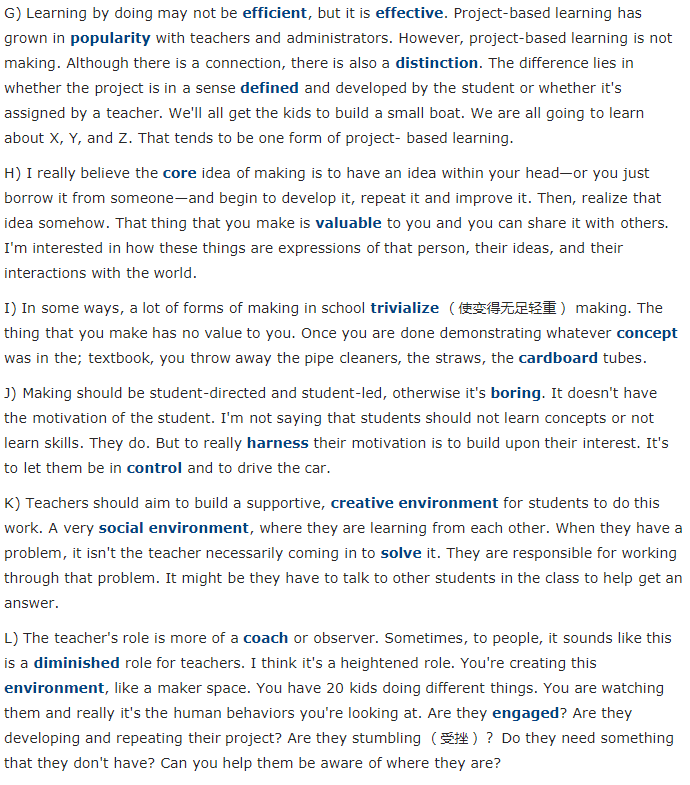
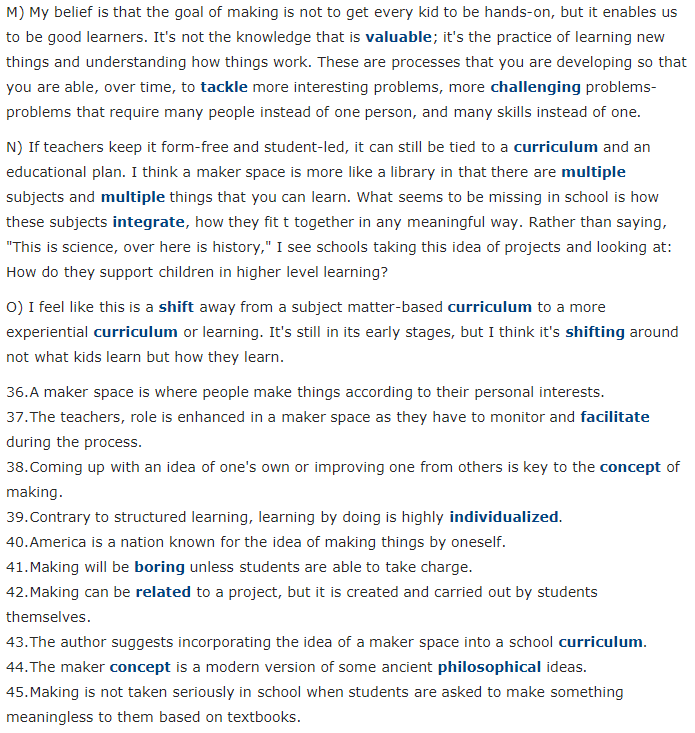
Professor Ashok Goel of Georgia Tech developed an artificially intelligent teaching assistant to help handle the enormous number of student questions in the online class, Knowledge-Based Artificial Intelligence. This online course is a core requirement of Georgia Tech's online Master of Science in Computer Science program. Professor Goel already had eight teaching assistants, but that wasn't enough to deal with the overwhelming number of daily questions from students.
Many students drop out of online courses because of the lack of teaching support. When students feel isolated or confused and reach out with questions that go unanswered, their motivation to continue begins to fade. Professor Goel decided to do something to remedy this situation and his solution was to create a virtual assistant named Jill Watson, which is based on the IBM Watson platform.
Goel and his team developed several versions of Jill Watson before releasing her to the online forums. At first, the virtual assistant wasn't too great. But Goel and his team sourced the online discussion forum to find all the 40,000 questions that had ever been asked since the class was launched. Then they began to feed Jill with the questions and answers. After some adjustments and sufficient time, Jill was able to answer the students' questions correctly 97% of the time. The virtual assistant became so advanced and realistic that the students didn't know she was a computer. The students, who were studying artificial intelligence, were interacting with the virtual assistant and couldn't tell it apart from a real human being. Goel didn't inform them about Jill's true identity until April 26. The students were actually very positive about the experience.
The goal of Professor Goel's virtual assistant next year is to take over answering 40% of all the questions posed by students on the online forum. The name Jill Watson will, of course, change to something else next semester. Professor Goel has a much rosier outlook on the future of artificial intelligence than, say, Elon Musk, Stephen Hawking, Bill Gates or Steve Wozniak.
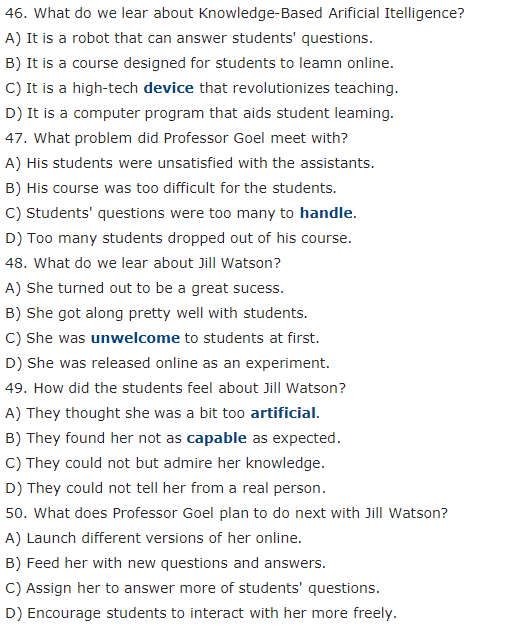
Thinking small, being engaging, and having a sense of humor don't hurt. Those are a few of the traits of successful science crowdfunding efforts that emerge from a recent study that examined nearly 400 campaigns. But having a large network and some promotional skills may be more crucial.
Crowdfunding, raising money for a project through online appeals, has taken off in recent years for everything from making movies to producing water-saving gadgets. Scientists have tried to tap Internet donors, too, with mixed success. Some raised more than twice their goals, but others have fallen short of reaching even modest targets.
To determine what separates science crowdfunding triumphs from failures, a team led by science communications scholar Mike Sch?fer of the University of Zurich examined the content of the webpages for 371 recent campaigns.
Four traits stood out for those that achieved their goals, the researchers report in Public Understanding of Science. For one, they use a crowdfunding platform that specializes in raising money for science, and not just any kind of project. Although sites like Kickstarter take all comers, platforms such as Experiment.com and Petridish.org only present scientific projects. For another, they present the project with a funny video because good visuals and a sense of humor improved success. Most of them engage with potential donors, since projects that answered questions from interested donors fared better. And they target a small amount of money. The projects included in the study raised $4,000 on average, with 30% receiving less than $1,000. The more money a project sought, the lower the chance it reached its goal, the researchers found.
Other factors may also significantly influence a project's success, most notably, the size of a scientist's personal and professional networks, and how much a researcher promotes a project on their own. Those two factors are by far more critical than the content on the page. Crowdfunding can be part of researchers' efforts to reach the public, and people give because "they feel a connection to the person" who is doing the fundraising—not necessarily to the science.
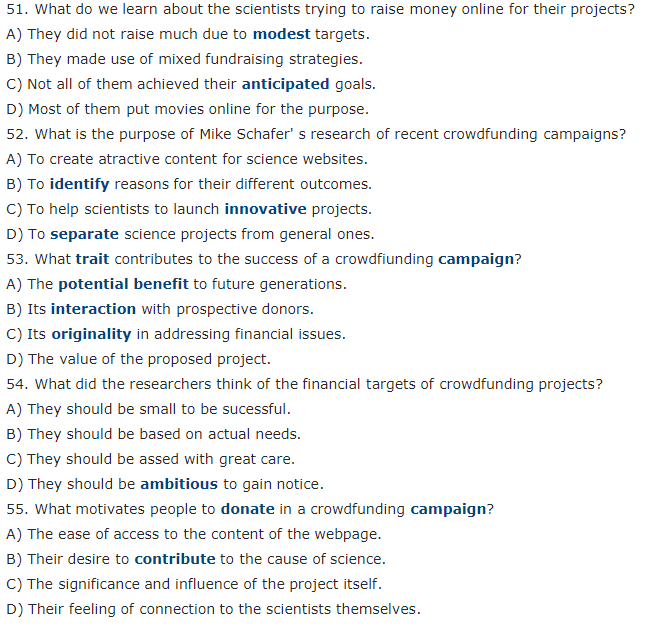
Directions: For this part, you are allowed 30 minutes to write a letter to a foreign friend who wants to study in China. Please recommend a university to him. You should write at least 120 words but no more than 180 words.
Directions: For this part, you are allowed 30 minutes to write a letter to a foreign friend who wants to teach English. Please recommend a city to him. You should write at least 120 words but no more than 180 words.
For this part, you are allowed 80 minutes to write a news report to your campus newspaper on a volunteer activity organized by your Student Union to assist elderly people in the neighborhood. You should write at least 120 words but no more than 180 words.
Ships are often sunk in order to create underwater reefs (暗礁) perfect for scuba diving (水肺式潜泳) and preserving marine __26__. Turkish authorities have just sunk something a little different than a ship, and it wouldn't normally ever touch water, an Airbus A300. The hollowed-out A300 was __27__ of everything potentially harmful to the environment and sunk off the Aegean coast today. Not only will the sunken plane __28__ the perfect skeleton for artificial reef growth, but authorities hope this new underwater attraction will bring tourists to the area.
The plane __29__ a total length of 54 meters, where experienced scuba divers will __30__ be able to venture through the cabin and around the plane's __31__ Aydin Municipality bought the plane from a private company for just under US $ 100, 000, but they hope to see a return on that __32__ through the tourism industry. Tourism throughout Turkey is expected to fall this year as the country has been the __33__ of several deadly terrorist attacks. As far as sunken planes go, this Airbus A300 is the largest __34__ sunk aircraft ever.
Taking a trip underwater and __35__ the inside of a sunken A300 would be quite an adventure, and that is exactly what Turkish authorities are hoping this attraction will make people think. Drawing in adventure seekers and experienced divers, this new artificial Airbus reef will be a scuba diver's paradise (天堂).
A) create
B) depressed
C) eventually
D) experiences
E) exploring
F) exterior
G) habitats
H) innovate
I) intentionally
J) investment
K) revealing
L) stretches
M) stripped
N) territory
O) victim